#White Tara Thangka
Explore tagged Tumblr posts
Text
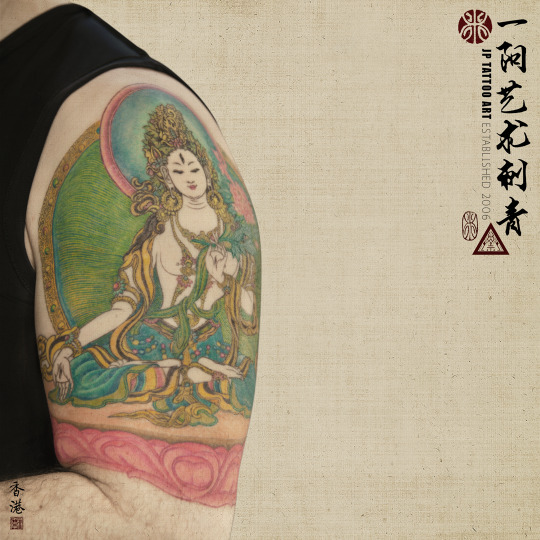
White Tara Thangka . . . #thangka #thangkatattoo #tangka #thanka #WhiteTara #ommanipadmehum #buddhism #asianinkandart #instattoo #instatattoo #tattoodaily #worldoftattoo #tattoohk #hktattoo #hongkongtattoo #唐卡 #紋身 #刺青 #佛 #白度母
#White Tara Thangka#thangka#thangkatattoo#tangka#thanka#WhiteTara#ommanipadmehum#buddhism#asianinkandart#instattoo#instatattoo#tattoodaily#worldoftattoo#tattoohk#hktattoo#hongkongtattoo#唐卡#紋身#刺青#佛#白度母
1 note
·
View note
Text

Constantly apply cheerfulness, if for no other reason than because you are on this spiritual path. Have a sense of gratitude to everything, even difficult emotions, because of their potential to wake you up.
~ Pema Chödron
42 notes
·
View notes
Text

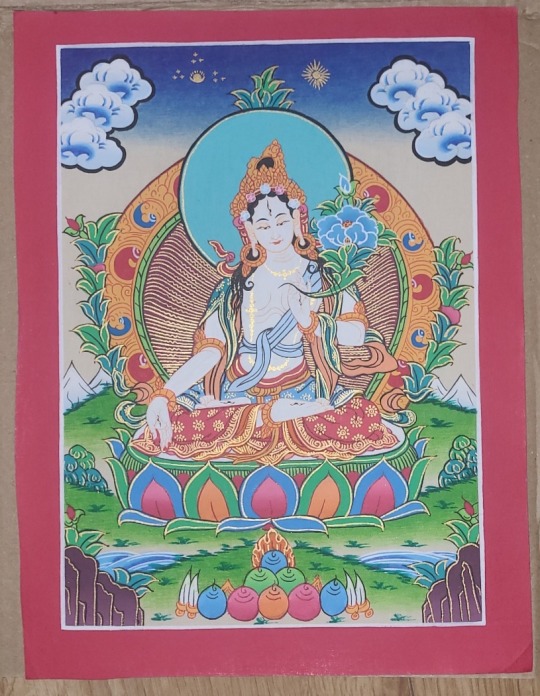
Thangkas I got from the UK based charity Tibet Relief Fund (only ship to UK unfortunately)
Top: Om mani padme hum thangka
Bottom: White Tara thangka
21 notes
·
View notes
Text


Green Tara (Goddess of compassion)
Talon Abraxas
Green Tara possesses the immense power of a divine being and the immense opulence of a divine being, as well as all of these precious jewels, which she can use to alleviate the suffering or poverty of all living things. She has a crown ornament that resembles a hat on the crown of her head, and a red figure is in the very center of that. The Buddha Amitabha, who is always red in color, is represented by that red figure at the very center of the reddish halo around her head. Green Tara signifies the energy winds of the body and breath, as well as the element of a Buddha that protects us from fear. Tara's influence is our ability to act, to move through life and to achieve our goals. Her name literally means "woman who ferries across."
Types of Green Tara
We can find ten different types of green tara on the basis of their symbolism, appearance, mudra, and iconography, each Tara is distinct from the others.
Khadiravani Tara Vasya Tara Arya Tara Mahatarri Tara Mahasri Tara Varada Tara Durgottarini Tara Dhanada Tara Jahguli Tara Parnasaban Tara Khadiravam Tara
In the Sadhansmala, Khadiravani Tara is depicted as being green and holding the Utasla on the left and the varada mudra on the right with two hands. She can be recognized by the presence of Asokakanta Marici and Ekajata. On her crown, she has Amoghaslddhi's image.
Vasya Tara
The European style of sitting known as Bhadrasana is Vasyatara's signature pose. She is, however, described as being single, and as such she is not accompanied by any gods or goddesses. She is portrayed by the Khadiravani class accompanied by Taras.
Arya Tara
This form of Tara is distinguished by the fact that she sits in the Ardhaparyahka posture and like Vasyatara she is completely alone. Vasyatara is said to have another name for Arya Tara. In the Ardhaparyahka posture, she is seated alone. She is green and has two arms.
Mahattari Tara
Mahattari Tara is distinguished by the Vajraparyahka posture in which she sits, as well as by the fact that she is represented alone. Mahattari Tara is a green goddess.
Mahasri Tara
Mahasri Tara is depicted as sitting on a golden throne that is covered in a variety of flowers. She has one face and two heads that are in the Vyakhyana Mudra. She wears ornaments and a crown with an image of Amoghasiddhi on it. Ekajata is seated in the ardhan pose and carries an angry face with a swelling abdomen. She holds the kartri and the kapala in her two arms and wears a dress made of tiger skin. Arya, jahguli is to the left of Mahasri Tara, Asokokanta, and Mahamayuri are to the right. Her green color comes from the Dhyani Buddha Amoghasiddhi.
Varada Tara
Varada Tara sits in the Ardhaparyanka position like Aryatara however she can be effortlessly perceived by the presence of four goddesses Asokakanta Marici, Mahamauri, Ekajata, and Janguli.
Durgottarani Tara
Durgottarini Tara has a green complexion, sits on a lotus, and wears white clothing. She has four arms, and the first pair of her hands are used to hold a noose and a goad. The second pair of her hands are used to show the Varada mudra and the lotus.
Dhanada Tara
Wealth Granting Tara is another name for Dhanada tara. Her second right hand is holding a rosary, and her first right hand is making the ultimate gesture of generosity. Utpala and a book are held in her two left hands. She has an animal as her Vahana, is accompanied by eight goddesses named after the eight vowels in her mantra, and her crown features an image of Amoghasiddhi. She sits in the sattva posture and is adorned with jewels and silks. She is surrounded by eight other Taras of varying hues and appearances, in addition to the four guards at her palace's entrances.
Jahguli Tara
Jahguli Tara can be yellow, white or green depending on where it comes from in Aksobhya. She carries the Trisula, the peacock's feathers and a snake in three of her hands when she is green, and she performs the Abhaya mudra with the fourth hand.
Parnasaban Tara
Parnasaban comes in different forms and colors. Some of them are as follows:
Parnasaban (green parnasaban)
When Parnasaban is green, it is emitted by Amoghasiddhi.
Parnasaban (yellow parnasaban)
Aksobhya is represented by Parnasaban in its yellow form. Parnasaban is typically three-faced and six-armed, but may have four arms in rare cases. The green variety is unique in that all three faces depict irritated smiles.
32 notes
·
View notes
Text
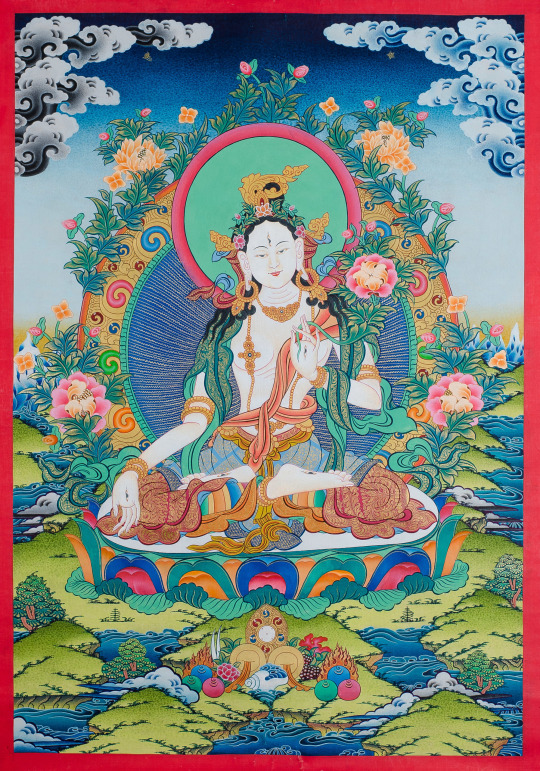
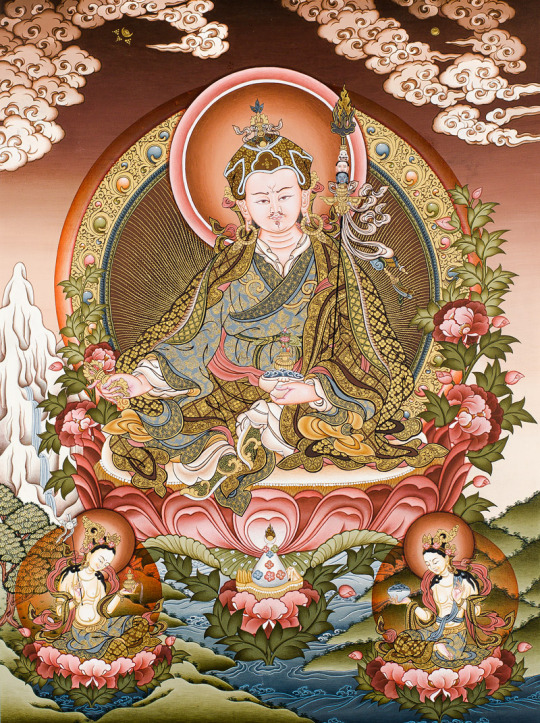


Thangkas of White Tara, Guru Rinpoche, Shakyamuni Buddha, and Chenrezig
"...the Peony has long been a deeply significant flower for Chinese culture (cultivated all the way back to 900 BC), and it’s also commonly known to the Chinese as the "Flower of Riches and Honor." It is common to see Peonies in paintings, ceramics and other household items in Asia.
Aside from the Lotus flower it is one of the most common flowers painted as a sacred offering flower in thangkas, or Tibetan paintings. It is commonly seen in Chinese, Korean and Japanese art as well."
25 notes
·
View notes
Note
I was browsing on internet looking at bodhisattva tara painting from nepal and tibet. I mistakingly the painting of parvati and shiva as bodhisattva tara and avalokitesvara. Even in tibetan thangka i mistakingly see saraswati as bodhisattva tara just because both of them have white skin
Their paintings and sculptures are always so pretty aahhhhhh.
I recently went to Sikkim last year, and we visited multiple monasteries and I think it was my favorite part of the whole trip. The colors, the incense, the serenity. Love it all.
8 notes
·
View notes
Text
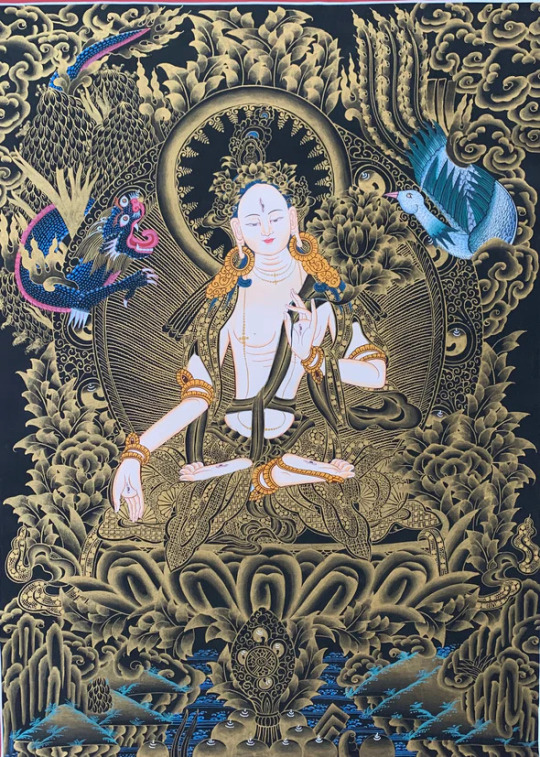
White Tara Thangka Painting has been part of Buddhist culture for centuries and has been passed down from generation to generation through this art form. It is believed that if you practice meditation on White Tara Thangka Painting, it will help you achieve inner peace and happiness.
Sacred Art of Nepal specializes in providing White Tara Thangka Painting for homes and offices throughout the USA. The company was founded by an expert painter who uses traditional techniques to create these unique pieces of art that are truly one-of-a-kind works of art!
For more details, please click the link below-
Contact: 641-919-2105
3 notes
·
View notes
Text

According to Vajrayana Buddhism Tara is completely enlightened Buddha who made a promise in the distant past that after reaching complete enlightenment she would always appear in the form of a female for the benefit of all beings. White Tara’s special function is to promote long life both for practitioner and for the others. Her practice means for attaining realization and accomplishing liberation.
White Tara is usually portrayed seated, dressed and crowned like Bodhisattvas. And sometimes she is regarded as Saptalochana or Seven eyes Tara. Extra Eyes on forehead, palm and feet and lotus flower at the one of her shoulder. She is related in Vajra posture, white in color and peaceable manifestation.
.
.
.
.
.
#lamathankapaintingschool #bhaktapurdurbarsquare #buddhism #tibetan #thangka #thankaschool #whitetara #tara #longevity #womendeity #dharma #purity #saptalochan #seveneyes #enlightened #bodhisattva #wisdom #himalayanart #sacred #livingheritage #heritage #newariart #dolma #wisdom #thankapainting
4 notes
·
View notes
Text
https://yunahandicrafts.com/product-category/tibetan-thangka-paintings/green-tara-white-tara-thangka-paintings/
1 note
·
View note
Photo

✨May the compassionate and healing energy of White Tara guide and protect us on our journey towards inner peace and well-being. 🙏🌸 #WhiteTara #ThangkaPainting #BuddhistArt #Compassion #HealingEnergy #thangka #thangkaart #buddha #buddhateachings #dhamma #prajna #wisdom #compassion #nonduality #awakening #innerself (at Nepal) https://www.instagram.com/p/CqICrcOPE8E/?igshid=NGJjMDIxMWI=
#whitetara#thangkapainting#buddhistart#compassion#healingenergy#thangka#thangkaart#buddha#buddhateachings#dhamma#prajna#wisdom#nonduality#awakening#innerself
1 note
·
View note
Photo

Large White Tara Painted Thangka, Dharamshala School, Mid-20th Century, India
2 notes
·
View notes
Text
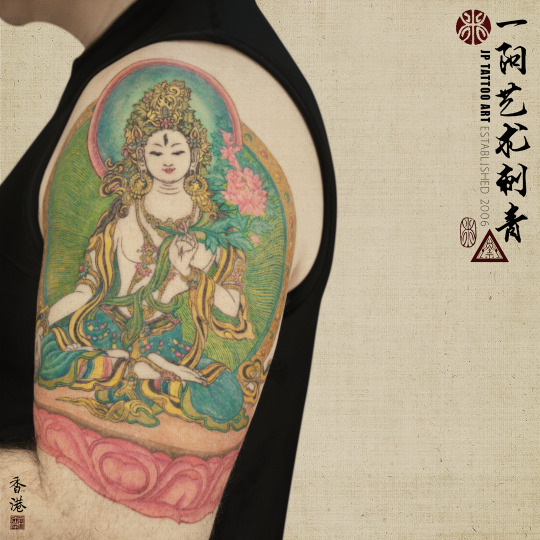
White Tara Thangka . . . #thangka #thangkatattoo #tangka #thanka #WhiteTara #ommanipadmehum #buddhism #asianinkandart #instattoo #instatattoo #tattoodaily #worldoftattoo #tattoohk #hktattoo #hongkongtattoo #唐卡 #紋身 #刺青 #佛 #白度母
#White Tara Thangka#thangka#thangkatattoo#tangka#thanka#WhiteTara#ommanipadmehum#buddhism#asianinkandart#instattoo#instatattoo#tattoodaily#worldoftattoo#tattoohk#hktattoo#hongkongtattoo#唐卡#紋身#刺青#佛#白度母
0 notes
Link
Lovely thangka painting with antique finish of White Tara, the bodhisattva of long-life. She has three eyes on her face and an eye on each palm of the hands and feet for a total of seven. The right hand rests across the knee in the gesture (mudra) of supreme generosity. The left hand holds to the heart the stem of a white lotus with pink shading; blossoming at the left ear.
4 notes
·
View notes
Photo
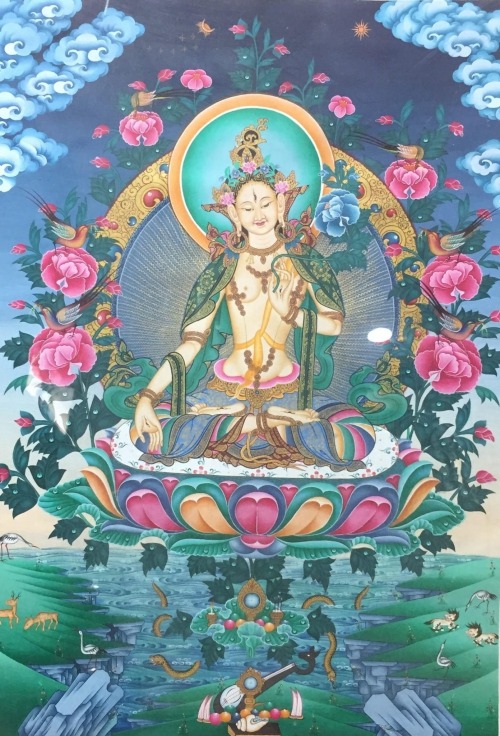

Om Tare Tu Tare Ture Mamaayuh Punya Janan Pustim Kuru Svaha
This Thangka is handpainted by the Nepali Thangka Artist from Bhaktapur, Nepal.
White Tara is peaceful deity sitting in vajra posture above a moon disc and lotus seat she is surrounded by a nimbus of various coloured rings and with pink lotus blossoms.
White Tara’s body is made of light. Transparent, it appears and yet is intangible, like a rainbow, mirage, or illusion.
In this way, her body represents the compatibility of the two truths conventional and ultimate. On the conventional level, she appears and exists.
White Tara conventionally appears, like an illusion, but ultimately cannot be found and is empty of an inherent essence.
She is the goddess of Increase Life and Wisdom. It is believed that White Tara is associated with Avalokitesvara, the god of compassion, and considered his female counterpart.
118 notes
·
View notes
Text

Green Tara (Goddess of compassion)
Talon Abraxas
Green Tara possesses the immense power of a divine being and the immense opulence of a divine being, as well as all of these precious jewels, which she can use to alleviate the suffering or poverty of all living things. She has a crown ornament that resembles a hat on the crown of her head, and a red figure is in the very center of that. The Buddha Amitabha, who is always red in color, is represented by that red figure at the very center of the reddish halo around her head. Green Tara signifies the energy winds of the body and breath, as well as the element of a Buddha that protects us from fear. Tara's influence is our ability to act, to move through life and to achieve our goals. Her name literally means "woman who ferries across."
Types of Green Tara
We can find ten different types of green tara on the basis of their symbolism, appearance, mudra, and iconography, each Tara is distinct from the others.
Khadiravani Tara Vasya Tara Arya Tara Mahatarri Tara Mahasri Tara Varada Tara Durgottarini Tara Dhanada Tara Jahguli Tara Parnasaban Tara Khadiravam Tara
In the Sadhansmala, Khadiravani Tara is depicted as being green and holding the Utasla on the left and the varada mudra on the right with two hands. She can be recognized by the presence of Asokakanta Marici and Ekajata. On her crown, she has Amoghaslddhi's image.
Vasya Tara
The European style of sitting known as Bhadrasana is Vasyatara's signature pose. She is, however, described as being single, and as such she is not accompanied by any gods or goddesses. She is portrayed by the Khadiravani class accompanied by Taras.
Arya Tara
This form of Tara is distinguished by the fact that she sits in the Ardhaparyahka posture and like Vasyatara she is completely alone. Vasyatara is said to have another name for Arya Tara. In the Ardhaparyahka posture, she is seated alone. She is green and has two arms.
Mahattari Tara
Mahattari Tara is distinguished by the Vajraparyahka posture in which she sits, as well as by the fact that she is represented alone. Mahattari Tara is a green goddess.
Mahasri Tara
Mahasri Tara is depicted as sitting on a golden throne that is covered in a variety of flowers. She has one face and two heads that are in the Vyakhyana Mudra. She wears ornaments and a crown with an image of Amoghasiddhi on it. Ekajata is seated in the ardhan pose and carries an angry face with a swelling abdomen. She holds the kartri and the kapala in her two arms and wears a dress made of tiger skin. Arya, jahguli is to the left of Mahasri Tara, Asokokanta, and Mahamayuri are to the right. Her green color comes from the Dhyani Buddha Amoghasiddhi.
Varada Tara
Varada Tara sits in the Ardhaparyanka position like Aryatara however she can be effortlessly perceived by the presence of four goddesses Asokakanta Marici, Mahamauri, Ekajata, and Janguli.
Durgottarani Tara
Durgottarini Tara has a green complexion, sits on a lotus, and wears white clothing. She has four arms, and the first pair of her hands are used to hold a noose and a goad. The second pair of her hands are used to show the Varada mudra and the lotus.
Dhanada Tara
Wealth Granting Tara is another name for Dhanada tara. Her second right hand is holding a rosary, and her first right hand is making the ultimate gesture of generosity. Utpala and a book are held in her two left hands. She has an animal as her Vahana, is accompanied by eight goddesses named after the eight vowels in her mantra, and her crown features an image of Amoghasiddhi. She sits in the sattva posture and is adorned with jewels and silks. She is surrounded by eight other Taras of varying hues and appearances, in addition to the four guards at her palace's entrances.
Jahguli Tara
Jahguli Tara can be yellow, white or green depending on where it comes from in Aksobhya. She carries the Trisula, the peacock's feathers and a snake in three of her hands when she is green, and she performs the Abhaya mudra with the fourth hand.
Parnasaban Tara
Parnasaban comes in different forms and colors. Some of them are as follows:
Parnasaban (green parnasaban)
When Parnasaban is green, it is emitted by Amoghasiddhi.
Parnasaban (yellow parnasaban)
Aksobhya is represented by Parnasaban in its yellow form. Parnasaban is typically three-faced and six-armed, but may have four arms in rare cases. The green variety is unique in that all three faces depict irritated smiles.
27 notes
·
View notes
Text

White Tara - Dolma Thangka Painting
White Tara is one of the forms of Tara. White Tara is also known as the mother of liberalization. She is a female Bodhisattva who sees all suffering and responds to requests for help. Tara is a meditation deity whose practice is believed to bring develop inner qualities and understand outer, inner, and secret teaching about compassion and emptiness. She is very quick to fulfill our wishes and to grant us happiness and long life, as well as to help us develop wisdom. By taking refuge in Tara and practicing meditation, visualizations, and having faith, you have the power to remove obstacles to your life and to prolong your life.
Mantra: Oṃ Tāre Tuttāre Ture Svāhā On this Thangka, White Tara also known as “Seven Eyed Tara” is seated on a white lotus with two arms and with eyes on her hand and feet, as well as the third eye on her forehead. She is known for compassion, long life, healing, and serenity. It is believed that White Tara is extremely powerful because Tara is very close to sentient beings, like a mother to her children.
17 notes
·
View notes